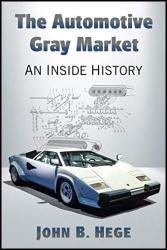 Название: The Automotive Gray Market: An Inside History
Название: The Automotive Gray Market: An Inside HistoryАвтор: John B. Hege
Издательство: McFarland
Год: 2022
Страниц: 192
Язык: английский
Формат: pdf (true), epub
Размер: 12.5 MB
In the 1970s, as car enthusiasts in the U.S. grew bored with models manufactured under tightening pollution and safety regulations, some innovative dealers exploited a legal loophole--designed to allow U.S. soldiers and diplomats to return from abroad with their vehicles--to import exotic cars never intended for sale in America. During the 1980s, a rise in the value of the dollar made car shopping in Europe a bargain hunter's dream. A network of unauthorized "gray market" importers and conversion shops emerged, bypassing factory channels and retrofitting cars to meet U.S. regulations and emission standards--at least in theory.
These cars had to pass through U.S. customs, a system equipped to handle only a few independent imports annually. As applications ballooned, the regulatory system collapsed. This is the story of a misunderstood but fascinating period in the automotive industry, when creative importers found ways to put American motorists in new Ferraris while the EPA and DOT were backed up with mounds of paperwork.
By the mid–1970s some foreign automakers had already thrown up their hands and abandoned the American market rather than bear the burdens imposed on car makers by an increasingly socially aware government. Even though I was only 16, I was outraged at the idea that masterpieces like the Maserati Bora or the then-concept Lamborghini Countach were not going to be available for sale in America.
To be sure, the Countach was a stunning car. The first preview came at the 1971 Geneva Motor show. It was a concept car, a kind of mission statement displaying to the automotive world the intentions of its parent company, Lamborghini. It was an outrageous statement to be made by the small sports car company started by an Italian tractor builder only eight years before. They had only been building cars since 1963 and could only produce a few of their hand-made cars each year. But the cars that they did build and deliver to their customers were creative, exciting, fast, and attracted attention everywhere they were seen. Consequently, they had little trouble selling them as fast as they could make them.
The number of cars brought into the States through such “Direct Importers” probably would never have amounted to much had it not been for a glitch in the international economy that took place in the first half of the 1980s. Many people remember the runaway inflation and high interest rates of the Carter years. Those interest rates made American dollars very valuable in foreign markets, nearly doubling the buying power of an American shopper overseas. Soon people realized that they could travel to Germany, buy a top-of-the-line Mercedes or other luxury car, ship it back to the States, and even after paying the cost of the shipping and compliance work, save thousands of dollars over the dealer’s price for the same car.
Скачать The Automotive Gray Market: An Inside History